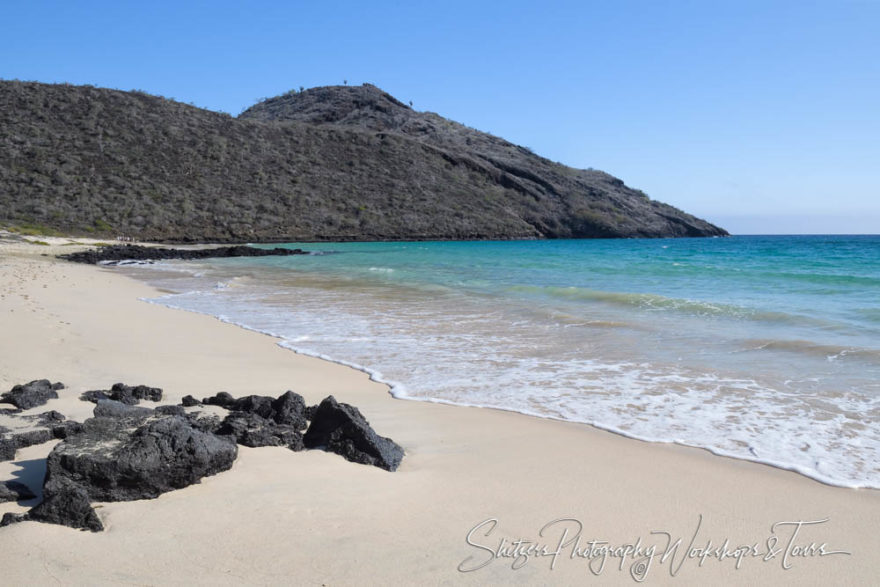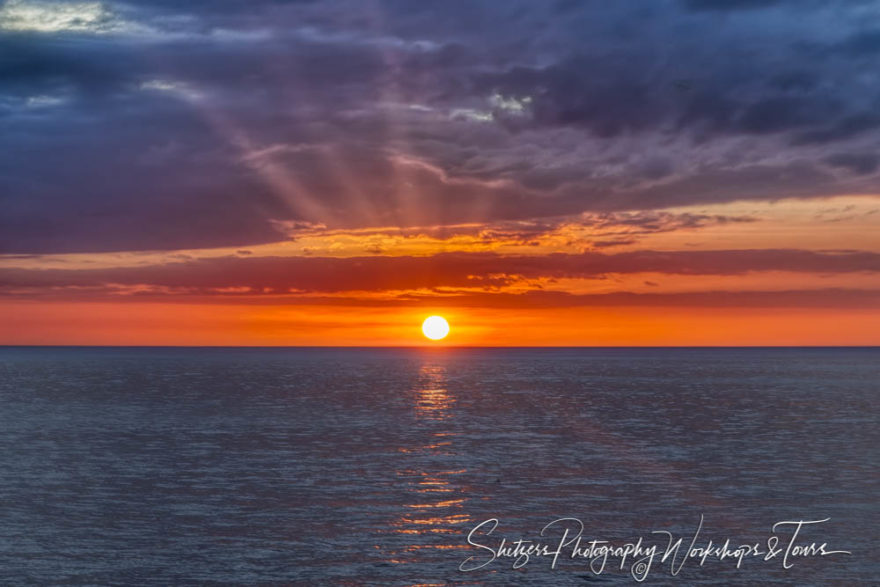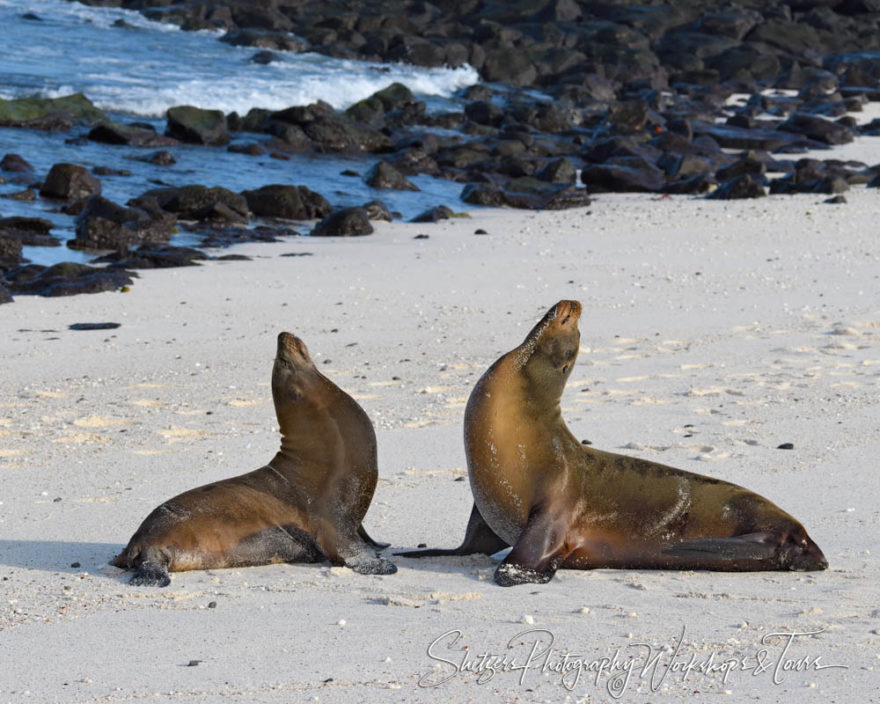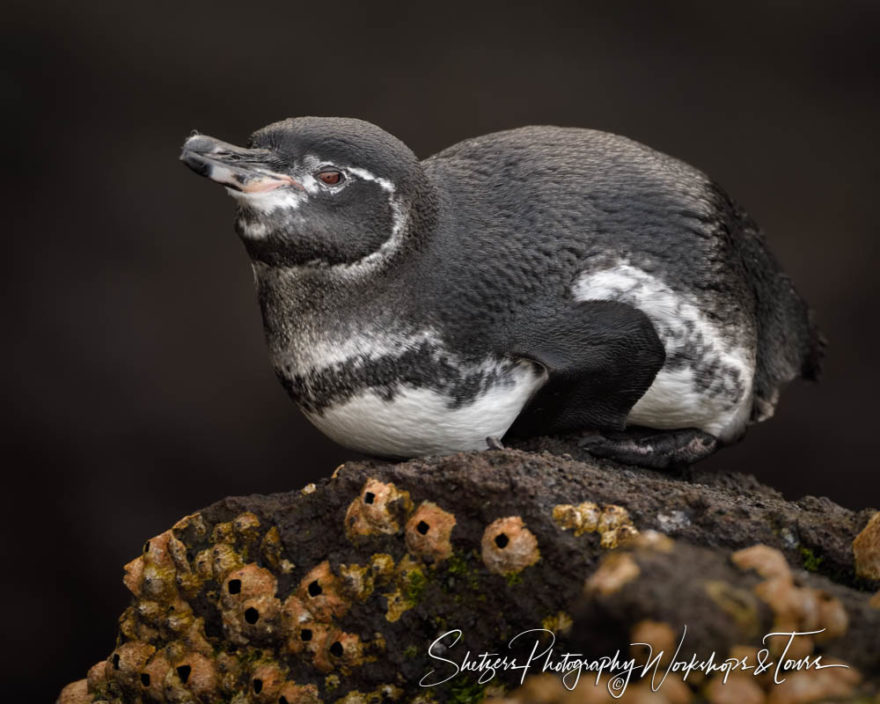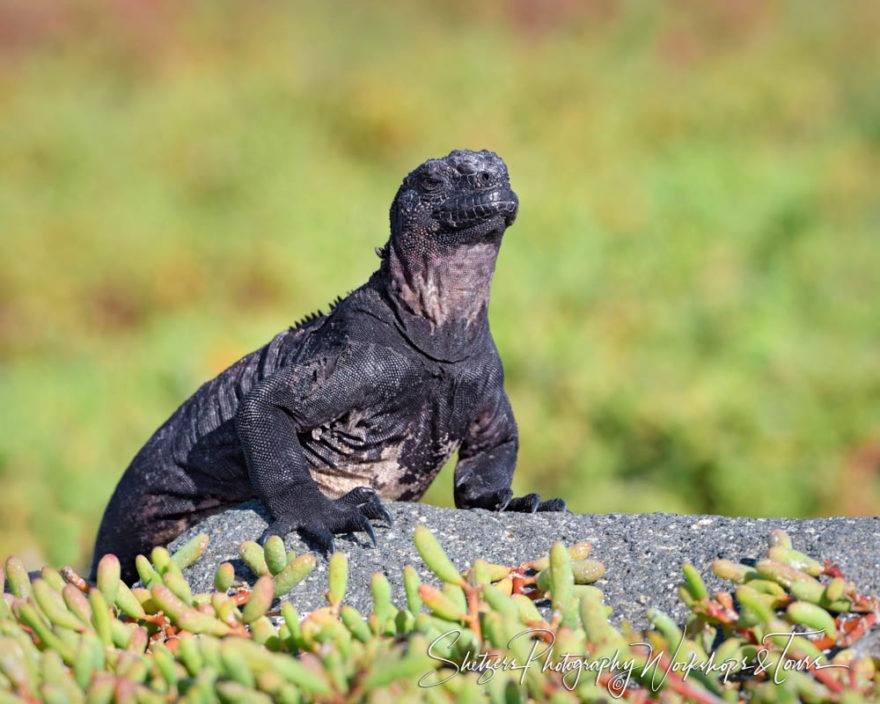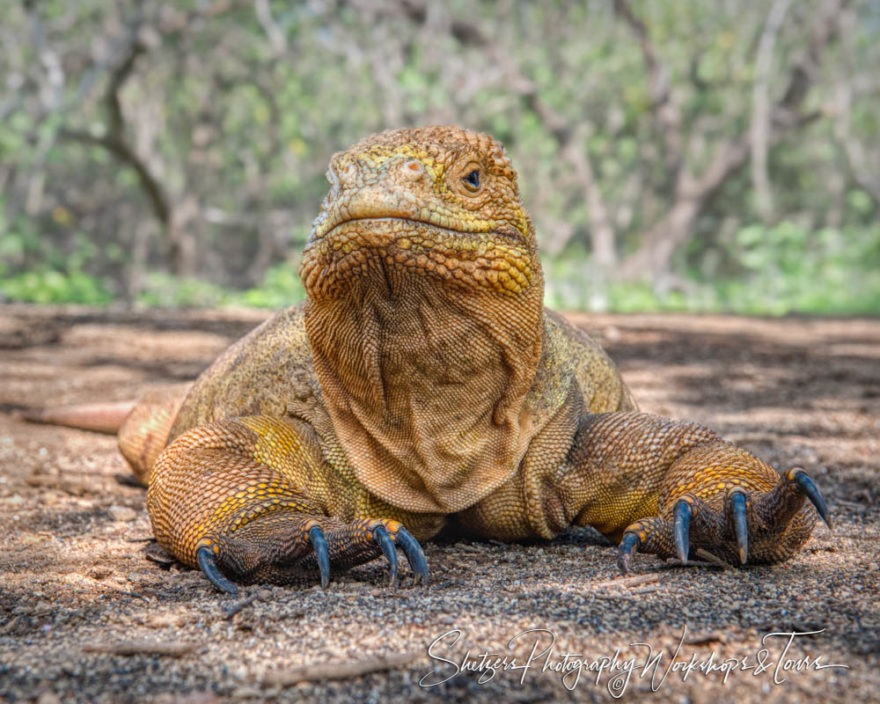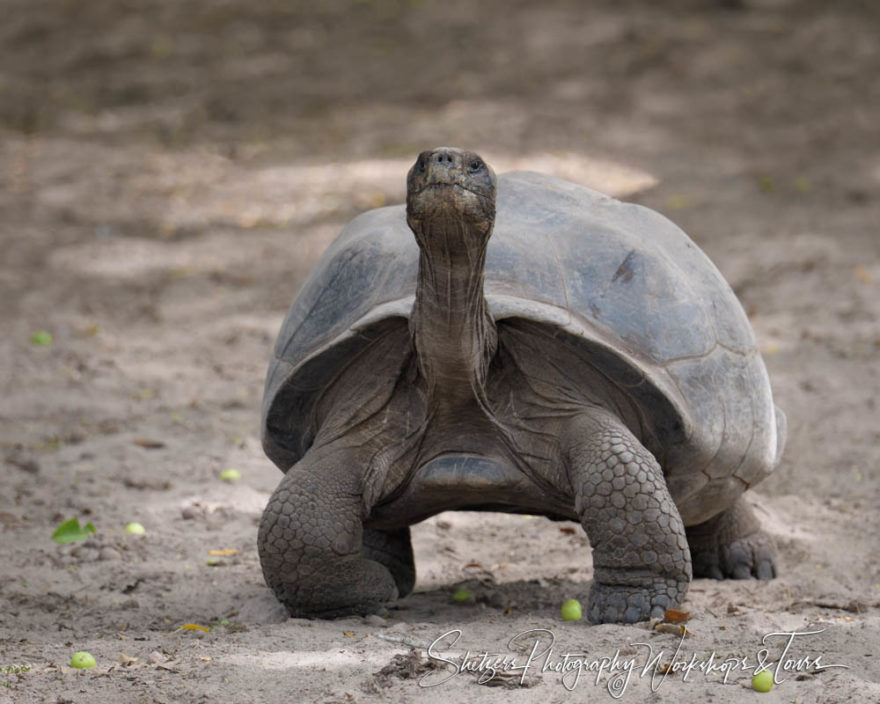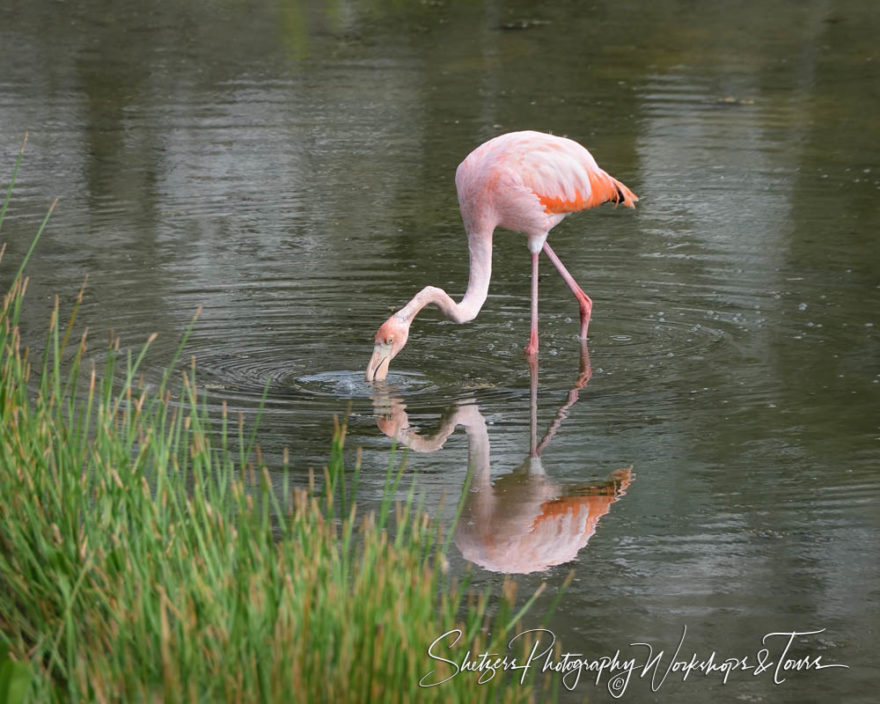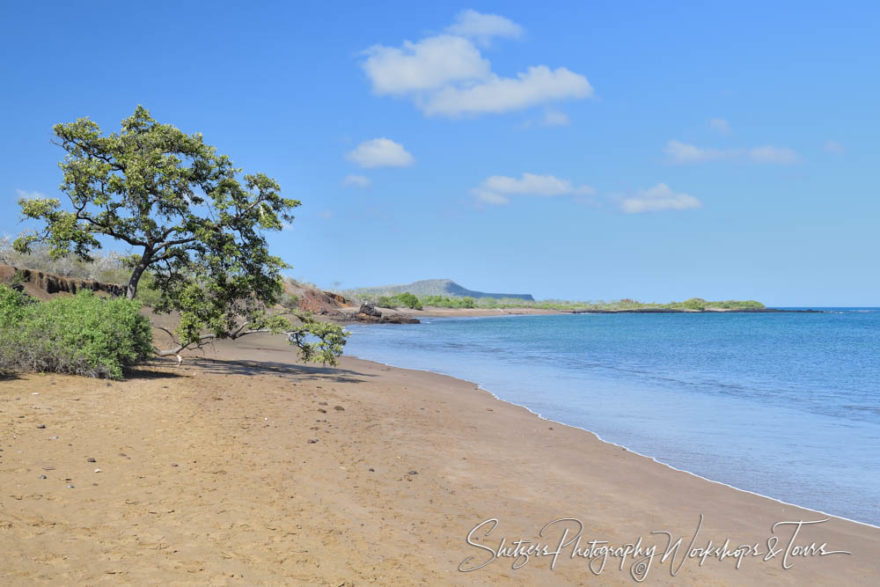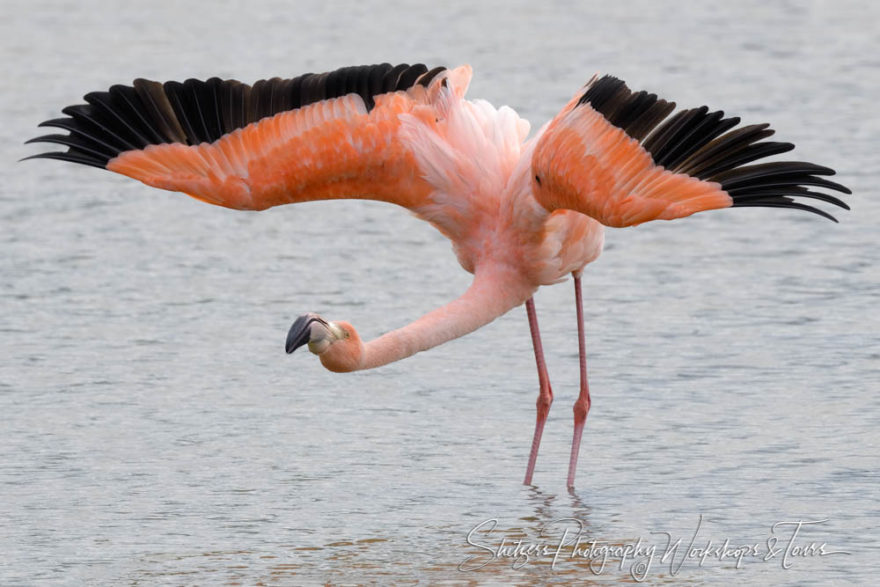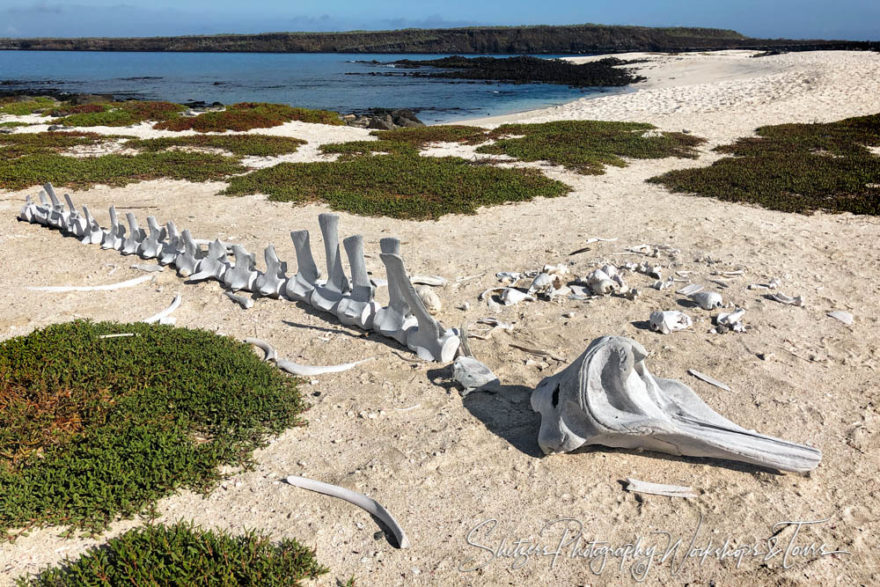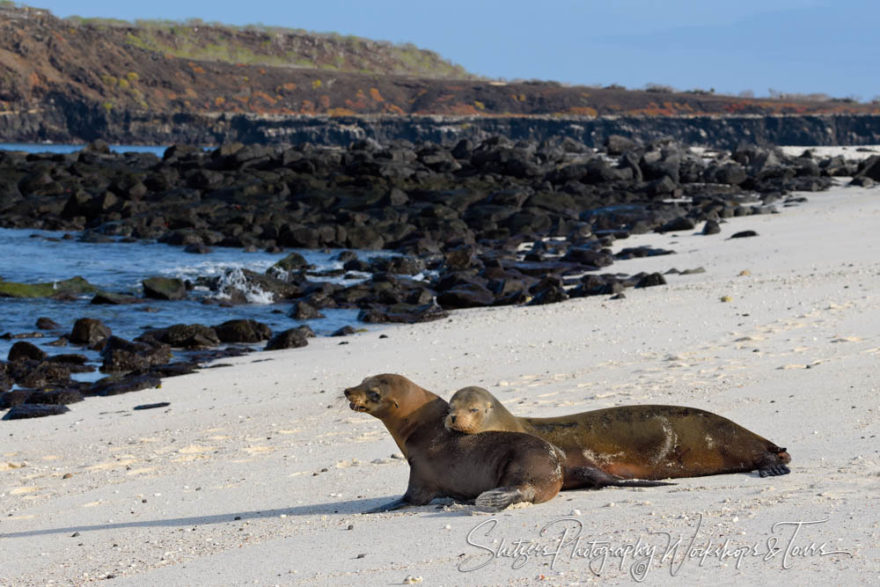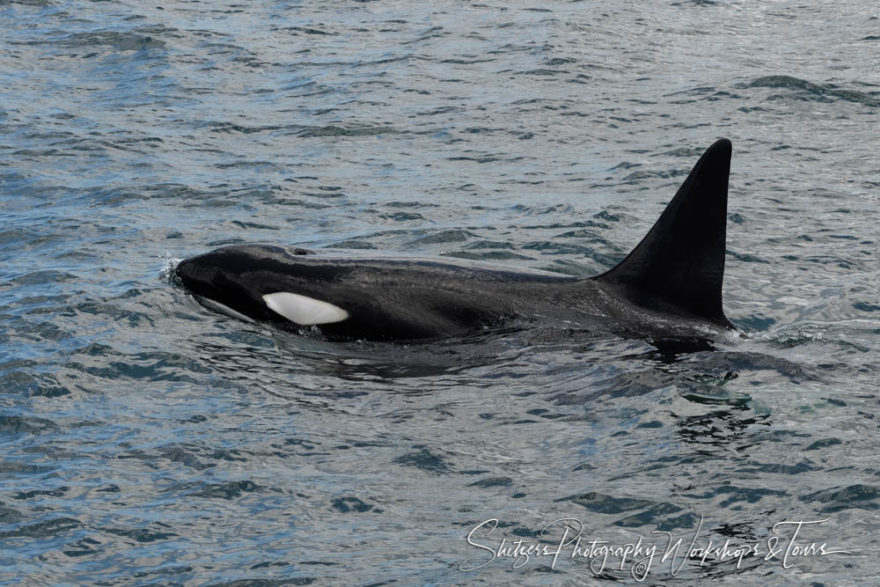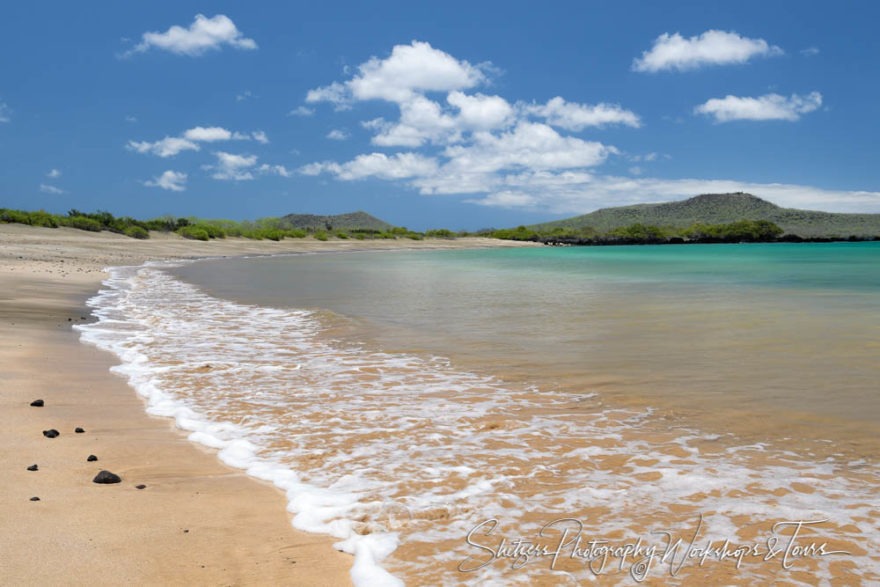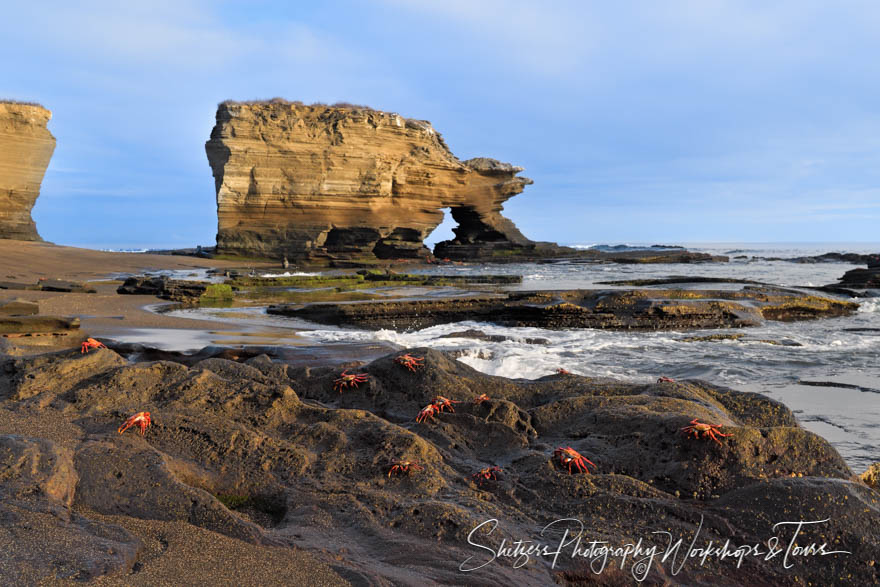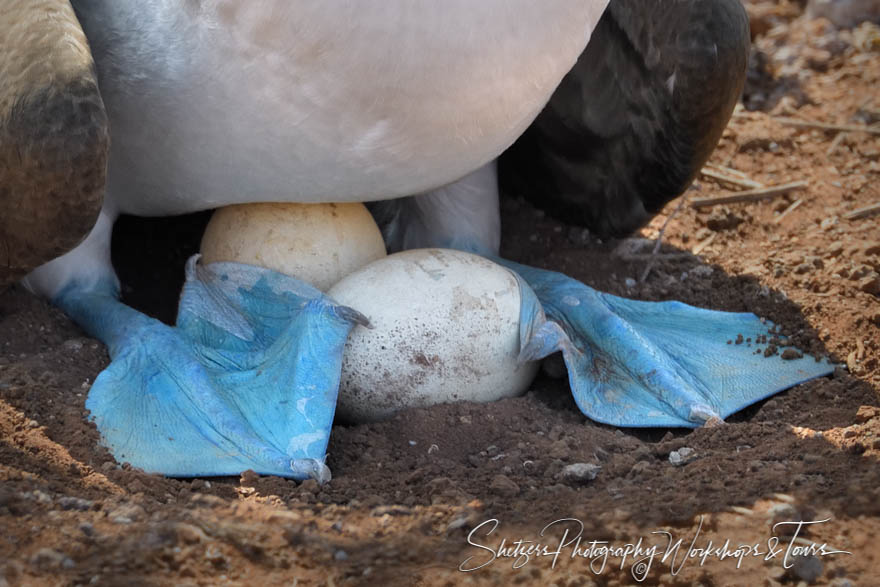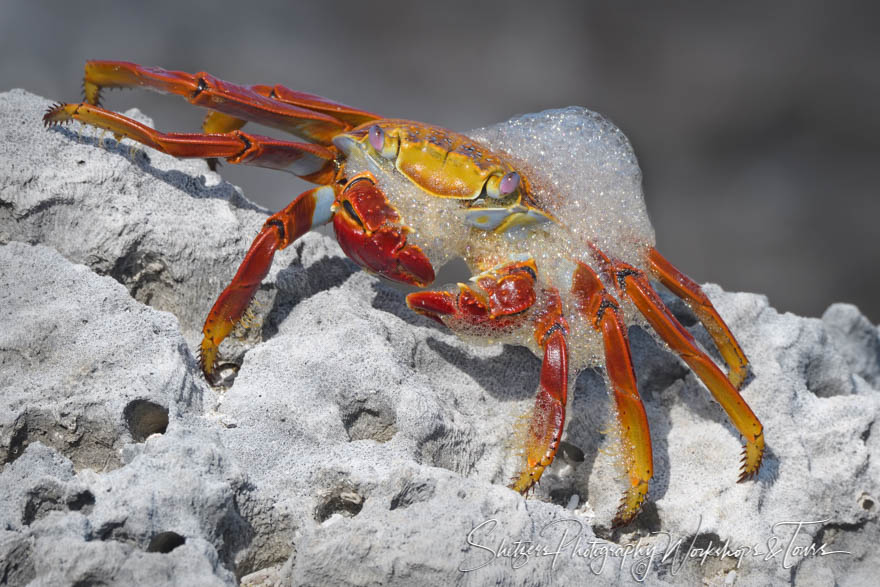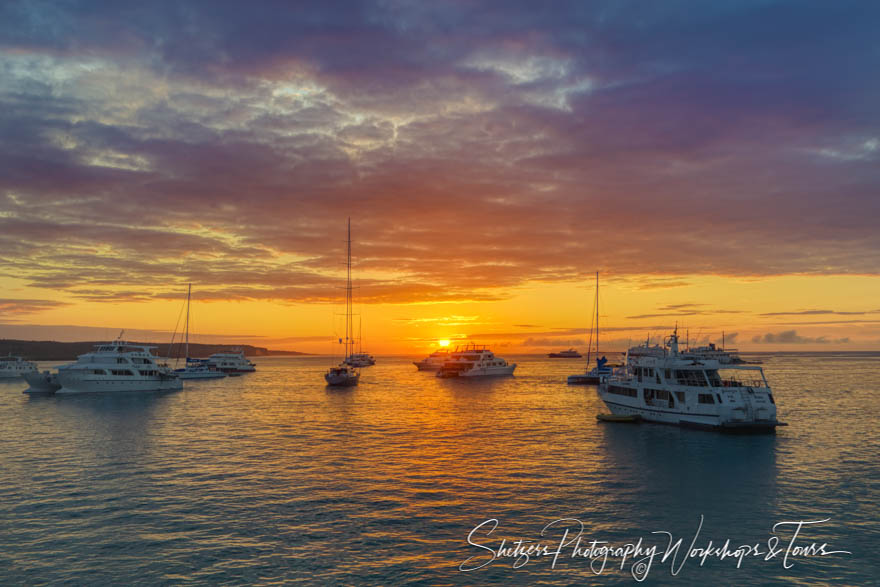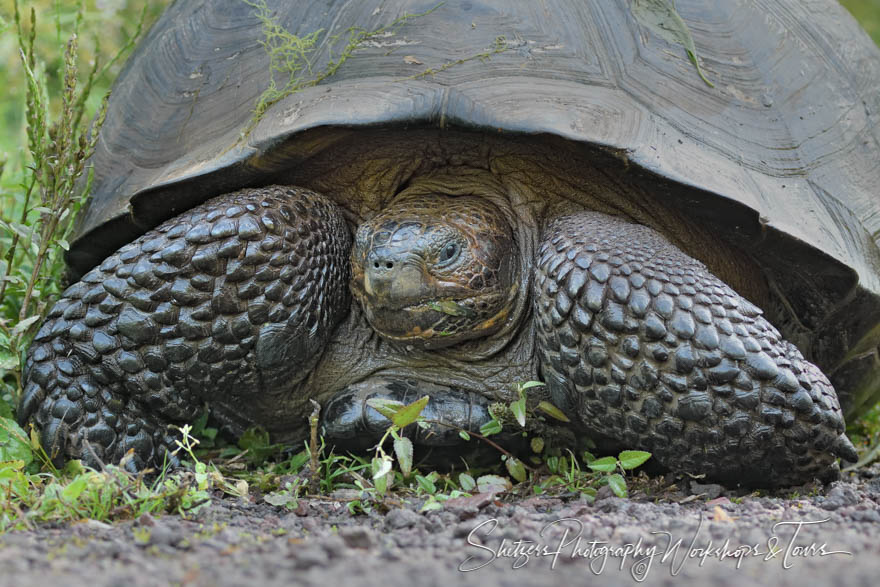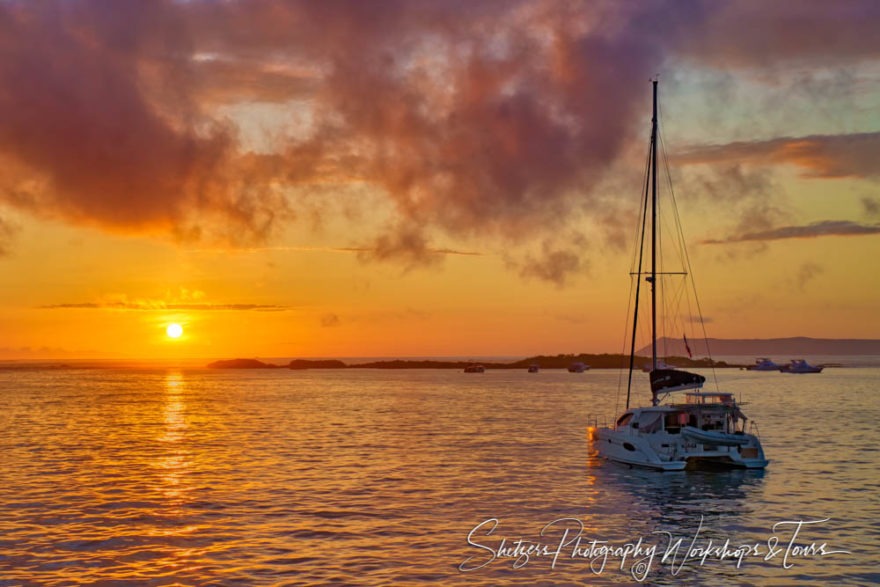Galápagos Photography Workshop – West
TABLE OF CONTENTS
Trip HighlightsItinerary/Details Register Ask Question
ITINERARY
Day 1 – Arrive Quito, Ecuador
At the start of the Galápagos Photography workshop, you will be greeted at the airport in Quito, Ecuador by our representative. Your driver will escort you to your hotel for the night, a historic colonial-style seventeenth-century building, just outside Quito, the second-largest city in this beautiful country.
The hotel has beautiful gardens whose trees are centuries old. If you have any free time, take advantage of gardens and look for the 33 species of birds that regularly visit.
Tonight, we will have a group dinner to get to know everyone, and talk about the exciting days to come in the Galápagos Islands.
For those arriving early, Quito has one of the best-preserved historic centers in the Americas, and is great to explore on foot.
Some places to explore prior to the workshop include:
- Plaza San Francisco and the Church and Convent of St. Francis
- Casa Gangotena (a recently restored historic mansion and boutique hotel)
- Carondelet Palace (the seat of government of the Republic of Ecuador)
- Basilica del Voto Nacional (the largest neo-Gothic basilica in the Americas)
- The Metropolitan Cathedral (one of the oldest and largest Roman Catholic cathedrals)
- Gold leaf interior of the Church of the Society of Jesus
- Church of San Francisco, Church of El Sagrario and Church of Santo Domingo
After dinner, we spend the night in the historic hotel. Get plenty of rest — tomorrow, we begin taking photographs in the beautiful Galápagos Islands.
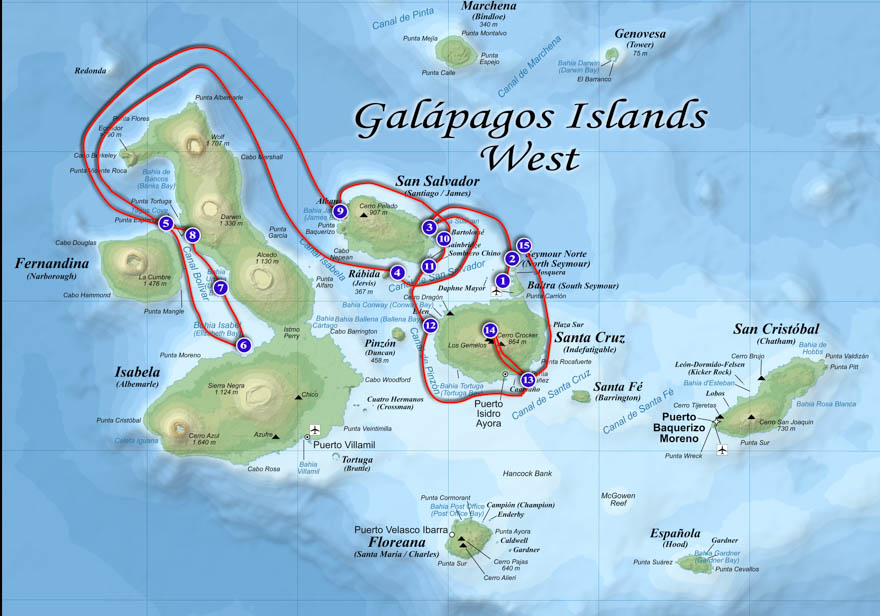
Galápagos Photography Workshop – West Route
Day 2 – Baltra Island (1) and Mosquera Island (2)
We head out early this morning from Quito to Baltra Island in the Galápagos Islands. As we over fly the Galápagos, you will notice signs of the volcanic history of these amazing islands. Upon arrival in the Galápagos, we will be met at the airport by our naturalist guide, and transferred to our chartered yacht for the week. We will meet the crew, get comfortable on the yacht, and enjoy a nice lunch as we depart Baltra for Mosquera Islet, our first excursion.
We will spend the afternoon at Mosquera Island, a small, sandy island between North Seymour and Baltra that was created by geological uplift. We will use the zodiacs to make a wet landing, then view one of the largest sea lion colonies in the Galápagos. There are multiple sea lion harems on the island – this is a spectacular location to observe and photograph their behaviors.
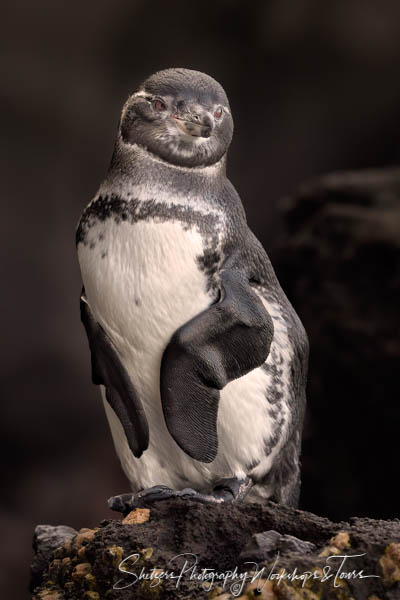
The adorable endemic Galápagos penguin
We hope to see Galápagos Sea Lions, Blue-footed boobies, lava herons, and other coastal birds, as well as marine iguanas, lava lizards, and colorful sally lightfoot crabs.
Some of the species we hope to photography while at Mosquera Island:
- Galápagos Sea Lion (endemic sub-species)
- Blue-footed booby (native)
- Marine Iguana (endemic)
- Galápagos heron or Lava heron (endemic)
- Lava Gull (endemic)
- Sanderling (migrant)
- Brown pelican (native)
- Great frigatebird (native)
- Sally Lightfoot Crabs
- Lava Lizards (endemic)
On Mosquera Island we are free to stroll on the beach looking for unique compositions, with the wildlife set against the textured lava rock and white sand beaches.
We will then head back to the boat for a short break, a snack, and our optional snorkeling trip for the day, a deep-water snorkel down a rock wall filled with colorful tropical fish.
Day 3 – Sullivan Bay (3) and Rabida Island(4)
This morning after breakfast we will take the zodiacs and make a wet landing to explore Sullivan Bay. You will notice the volcanic origins of this area.
After lunch we take the zodiacs over to beautiful Rabida Island, where the sand is a deep red color due to the ferric oxide in the lava. We look for sea lions, blue-footed boobies, marine iguanas, and shore birds, then take a short hike back to a saltwater lagoon where we hope to find colorful greater flamingos and white-cheeked pintail ducks.
- Greater flamingo (native)
- Brown Noddy (native)
- Brown pelican (native)
- Elliot’s Storm Petrel (native)
- Galápagos mockingbirds (endemic)
- Galápagos petrel (endemic)
- Blue-footed booby (native)
- Yellow-Crowned Night Heron (native)
- Sally Lightfoot Crabs
- Galápagos Sea Lion (endemic sub-species)
- Galápagos Green Turtle (endemic sub-species)
- Lava Lizards (endemic)
- Marine Iguana (endemic)
Behaviors on Rabida Island:
- Galápagos Sea Lions playing on the red sand beach
- Greater Flamingos feeding in lagoon
- Galápagos Mockingbirds feeding
- Pelicans feeding
- Galápagos Green sea turtles feeding
- Lava Lizards males doing “push-ups”
We then hop back into the zodiacs and go around the corner of the island to do a little snorkeling with all the colorful fish.
Then we head back to the boat for snacks and a relaxing navigation to the largest island in the Galápagos, the island of Isabela.
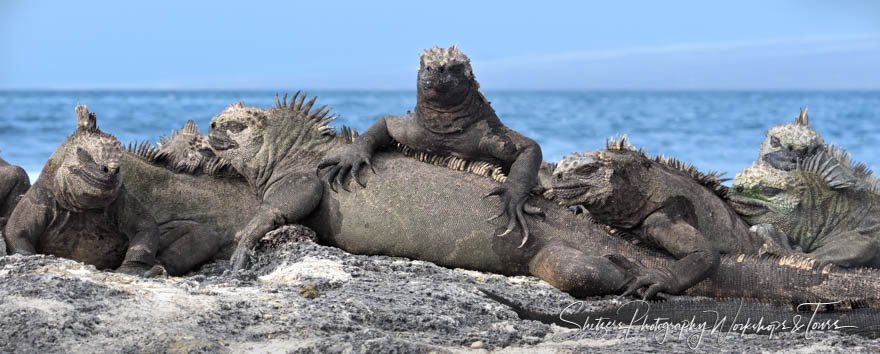
Lots of marine iguanas warming themselves on the lava rock
Day 4 – Fernandina Island – Espinosa Point (5) and Isabela Island – Elizabeth Bay (6)
This morning, we will explore Fernandina Island’s Espinosa Point, one of the highlights of the Galápagos Photography Workshop.
Another short hike on this narrow stretch of land will take us to a stretch of black lava rock teeming with marine iguanas. This is one of the best spots to photograph iguanas in large groups.
Fernandina Island is an extremely active volcano — it has erupted 22 times in last 200 years. It is the youngest and most volatile island in the whole Galápagos chain.
As we explore the lava coast and snap pictures of the thousands of marine iguanas, we will also get a chance to view a lava flow up close. Here, the endemic Lava Cactus grows in large groups on the black lava rock. Bring your landscape lens: the leading lines and textures are excellent.
- Marine Iguana (endemic)
- Galápagos Hawks (endemic)
- Lava Cactus (endemic)
- Galápagos heron or Lava heron (endemic)
- Blue-footed booby (native)
- Galápagos Sea Lion (endemic sub-species)
- Flightless cormorant (endemic)
- Galápagos shearwater (endemic)
- Galápagos Dove (endemic)
- Lava Gull (endemic)
- Galápagos Green Turtle (endemic sub-species)
- Semi-palmated plover (migrant)
- American oystercatcher (native)
- Brown pelican (native)
- Hermit Crabs (native)
- Sally Lightfoot Crabs
- Lava Lizards (endemic)
We will also keep our eyes out for more Galápagos Sea lions and Galápagos penguins. (You can never photograph too many penguins!)
When we return to the boat, you will have an option to go snorkeling.
After lunch, we will explore Elizabeth Bay on west side of Isabela Island, a spot where wildlife is abundant. Using the zodiacs, we will tour the protected mangrove forests and see all four types of mangroves: white, black, button, and red. The mangrove trees at Elizabeth Bay are the tallest in the Galápagos Islands.
As we meander around the mangroves, Galápagos green turtles will be feeding on the algae, while Galápagos penguins swim around the bay and nest on the lava rocks. In the air, we will see lots of blue-footed boobies, great frigatebirds, and brown pelicans diving for fish.
- Galápagos Green Turtle (endemic sub-species)
- Galápagos Penguin (endemic)
- Galápagos Sea Lion (endemic sub-species)
- Blue-footed booby (native)
- Great frigatebird (native)
- Flightless cormorant (endemic)
- Galápagos heron or Lava heron (endemic)
- Galápagos mockingbirds (endemic)
- Yellow warbler (endemic)
- Brown Noddy (native)
- Brown pelican (native)
- Franklin’s gull (native)
- Magnificent frigatebird (native)
- Lava Lizards (endemic)
Day 5 – Isabela Island – Urbina Bay (7) and Tagus Cove (8)
This morning we head out to Isabela Island’s Urbina Bay, land that rose out of the sea at the foot of the Alcedo Volanco. We will take the zodiacs in for a wet landing on the beach. On the shore we hope to photograph land iguanas, flightless cormorants, pelicans, lava lizards, and mockingbirds.
As we walk around the trails, we hope to see the Galápagos tortoise, the largest tortoise in the world. Galápagos tortoises are so well adapted to this arid landscape that they can survive a year without eating or drinking.
Some of the species we hope to photograph while at Urbina Bay:
- Giant Tortoises (endemic)
- Land Iguana (endemic)
- Galápagos mockingbirds (endemic)
- Blue-footed booby (native)
- Darwin’s Finches or Galápagos Finches (endemic)
- Flightless cormorant (endemic)
- Yellow warbler (endemic)
- Marine Iguana (endemic)
- Galápagos Green Turtle (endemic sub-species)
- Brown pelican (native)
- Hermit Crabs (native)
- Lava Lizards (endemic)
We will use a unique method to get around this island: walking along a former coral bed that has risen above the surface, taking photographs as we go. After our short hike, we will have the chance to go snorkeling and search underwater for Galápagos green turtles.

Sally Lightfoot crabs are one of the symbols of the Galapagos Islands, seen in great numbers on almost any shoreline in the archipelago.
This afternoon we will explore Isabela Island’s Tagus Cove. This protected cove on the west side of Isabela was a favorite resting site for pirates, who preserved their names for history by carving them into the high cliffs of the bay.
After lunch, we will take the zodiacs in for a dry landing on the island. We will take a scenic hike uphill to Darwin Lake, a unique saltwater crater lake. The trail will take us up a parasitic spatter cone toward great views of the lava fields surrounding Darwin Volcano.
Once we complete our hike, we will aim to photograph Galápagos penguins (the only penguins in the Northern hemisphere), blue-footed boobies, and flightless cormorants. Flightless cormorants are an interesting case study of evolution: their wings are too small to fly, illustrating how their environment has selected for other traits over time.
- Galápagos Penguin (endemic)
- Flightless cormorant (endemic)
- Blue-footed booby (native)
- Galápagos Sea Lion (endemic sub-species)
- Galápagos petrel (endemic)
- Galápagos Green Turtle (endemic sub-species)
- Darwin’s Finches or Galápagos Finches (endemic)
- Galápagos shearwater (endemic)
- Marine Iguana (endemic)
- Wilson’s phalarope (migrant)
- Brown pelican (native)
- Elliot’s Storm Petrel (native)
- Magnificent frigatebird (native)
- Sally Lightfoot Crabs
- Bottle-nosed Dolphin
- Lava Lizards (endemic)
- Manta Ray
After a short break, we will visit a fascinating snorkeling location in Tagus Cove, featuring marine invertebrates and vertical walls. In addition to colorful fish, we hope to see Galápagos green turtles and Galápagos penguins swimming amid the walls and coves.
Day 6 – Santiago Island – Egas Port (9) and Bartolome Island (10)
We leave the boat early after breakfast to photograph the tidal zones on Santiago Island. We land on a black beach where the sand is crushed volcanic rock.
Exploring the tidal zones, keep your eyes out for the wildlife that enjoys this climate. We hope to see marine iguana enjoying the tide pools, as well as Galápagos herons and yellow-crowned night heron searching for food. The sally lightfoot crabs are plentiful here and extremely photogenic against the black lava rock.
- Marine Iguana (endemic)
- Land Iguana (endemic)
- Yellow-Crowned Night Heron (native)
- Galápagos Fur Seals (endemic)
- Brown pelican (native)
- Elliot’s Storm Petrel (native)
- Galápagos flycatcher (endemic)
- Galápagos Hawks (endemic)
- Galápagos heron or Lava heron (endemic)
- Great frigatebird (native)
- Galápagos mockingbirds (endemic)
- Galápagos petrel (endemic)
- Lava Gull (endemic)
- Semi-palmated plover (migrant)
- Smooth-billed ani (introduced)
- Sally Lightfoot Crabs
- Galápagos Sea Lion (endemic sub-species)
- Lava Lizards (endemic)
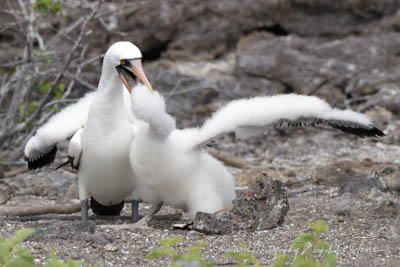
A Nazca booby feeds her young chick on one of the nesting islands we visit during the week
As we near the end of our hike, we hope to see Galápagos fur seals hanging out in the grottos as the water surges in and out. The grottos are holes in the volcanic rock that the tide can flow through, creating blowholes at high tide, and showing how vibrantly green the water is in the Galápagos Islands.
Behaviors we typically see at Puertos Egas on Santiago Island:
- Galápagos Fur Seals swimming in the green grottos
- Night and Galápagos herons fishing
- Marine Iguanas sunning themselves in the tidal pools
- Sally Lightfoot Crabs scavenging the beach for food
- Galápagos flycatcher feeding
This afternoon we explore Bartolome Island, and climb to its scenic overlook, 114 meters high. We take the zodiacs to a dry landing and follow the boardwalk to many interesting stopping places. As we get to the top, we take in the wonderful views across Bartolome, toward Santiago, Sullivan Bay, and the surrounding islands.
Jutting out of the ground is Pinnacle Rock, a famous landmark of Bartolome, where the movie Master and Commander was filmed. We see swells breaking into volcanic ovens, accenting them with clean white foam. We also see lava cactus, known as the “queen of the night” for its flowers that bloom after dark, and other plants that thrive in this dry and harsh climate.
After descending from the peak of Bartolome, we will use the zodiacs to go in search of Galápagos penguins in the lava tubes of this rugged shore. We hope to see the Galápagos penguins preening, socializing with each other, and jumping in and out of the water as they search for food.
As we tour in the Zodiacs, keep looking on the lava rock for the penguins, along with blue-footed boobies, nazca boobies, and Galápagos green turtles.
- American oystercatcher (native)
- Blue-footed booby (native)
- Brown pelican (native)
- Darwin’s Finches or Galápagos Finches (endemic)
- Elliot’s Storm Petrel (native)
- Galápagos Hawks (endemic)
- Galápagos heron or Lava heron (endemic)
- Galápagos Penguin (endemic)
- Galápagos petrel (endemic)
- Great blue heron (native)
- Large cactus finch (endemic)
- Sharp-beaked ground-finch or Vampire finch (endemic)
- Warbler-finch (endemic)
- Sally Lightfoot Crabs
- Galápagos Sea Lion (endemic sub-species)
- Lava Cactus
- Lava Lizards (endemic)
- Nazca booby (native)
As the sun gets low, we head back to the yacht and enjoy a chef-prepared dinner and another informative presentation about the Galápagos islands from our Galápagos naturalists.
Day 7 – Sombrero Chino Island – Chinese Hat (11) and Santa Cruz Island – Dragon Hill (12)
Sombrero Chino, or Chinese Hat, is a beautiful island with lava flows and white sandy beaches, bordering a 200-meter wide channel that separates it from the larger island of Santiago.
The island gets its name from the conical hat worn by many Asian rice farmers, which actually originates from Vietnam. The vibrant green/aqua waters that surround the island are full of wildlife.
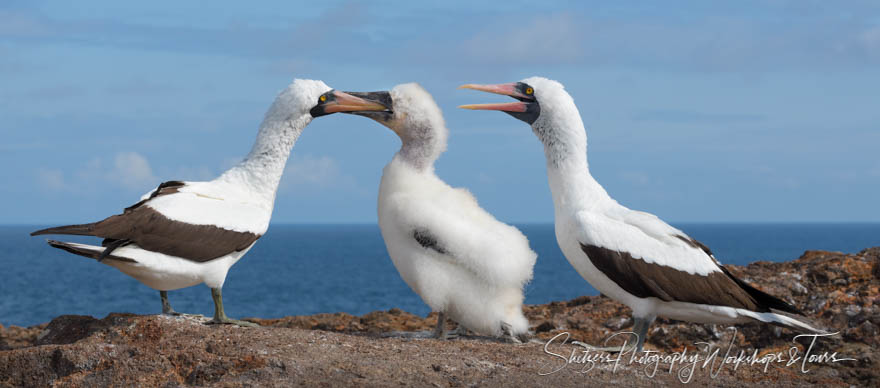
A Nazca booby family takes care of their new chick
This morning, we explore the island after a wet landing on a small white coral beach. As we take a leisurely walk on the coast among fragile lava and lava tubes, we hope to see the Galápagos penguin, the only penguin in the northern hemisphere. These playful and photogenic critters perch on the black lava rock and dive into the colorful water in search of fish.
We will also visit Galápagos sea lion colonies, and hope to photograph them playing and nursing their young. The young sea lions play together in “nurseries” while their mothers go out to fish.
- Galápagos Penguin (endemic)
- Galápagos Sea Lion (endemic sub-species)
- Galápagos heron or Lava heron (endemic)
- Galápagos petrel (endemic)
- Brown pelican (native)
- Elliot’s Storm Petrel (native)
- Spotted eagle rays
- Galápagos Hawks (endemic)
- Great blue heron (native)
- Great frigatebird (native)
- Sally Lightfoot Crabs
- Lava Lizards (endemic)
- Marine Iguana (endemic)
Marine iguanas lounge around sunning themselves on the black lava rock, while pelicans and great blue herons feed on the abundant food in this area.
Make sure to bring your landscape lens, as the landscapes are just as impressive as the wildlife.
A few behaviors on Chinese Hat that we hope to see:
- Galápagos Sea Lion playing
- Baby Galápagos penguins posing
- Young Galápagos Sea Lions playing in the ‘nursery’
After a snack, we have the option to go snorkeling, and visit all the wildlife that lives below the water between Chinese Hat and Santiago. With support of a zodiac, we will enjoy a relaxing view of aqua-green waters and coral reefs.
As you enter the water, you will notice the thousands of fish that help support all the seabirds we have seen so far. The colorful tropical fish are not bothered by our presence. In addition to the fish, we hope to see the Galápagos penguin, Galápagos sea lion, and spotted eagle rays.
After a very busy morning, we head back to the boat for a short rest, and then lunch.
After lunch, we will make our way to Santa Cruz Island and Dragon Hill. Dragon Hill is a beautiful location with white beaches, black lava rock, and a hill with great views of the area. We will take a short hike to photograph flamingos, common stilts, great blue herons, lava herons, and mockingbirds at the hyper-saline lagoon.
Our hike continues up Dragon Hill toward beautiful views of the bay. Make sure you bring your landscape lens, as well as your wildlife lens for our next destination: a nesting site of land iguanas.
Many land iguanas call this area home. They are such a unique reptile, and their yellow textures photograph very nicely.
- Land Iguana (endemic)
- Galápagos flycatcher (endemic)
- Galápagos mockingbirds (endemic)
- Large Ground-finch (endemic)
- Small ground finch (endemic)
- Yellow warbler (endemic)
- Marine Iguana (endemic)
- Whimbrel (migrant)
- Wilson’s phalarope (migrant)
- Blue-footed booby (native)
- Brown pelican (native)
- Great blue heron (native)
- Great frigatebird (native)
- Sally Lightfoot Crabs
- Lava Lizards (endemic)
Day 8 – Santa Cruz Island – Puerto Ayora (13), Santa Cruz Highlands (14)
This morning, we head into the Highlands of Santa Cruz Island in search of Galápagos tortoises and visit the Twin Craters. As we climb in elevation, you will notice the vegetation increases in size, providing an ideal habitat for the tortoises. At the high point on the road, we will re-enter the National Park system. We will spend the morning walking the trails and taking photos of the amazing tortoises who roam the grassy meadows and highland ponds. We will enjoy a lunch at the farm
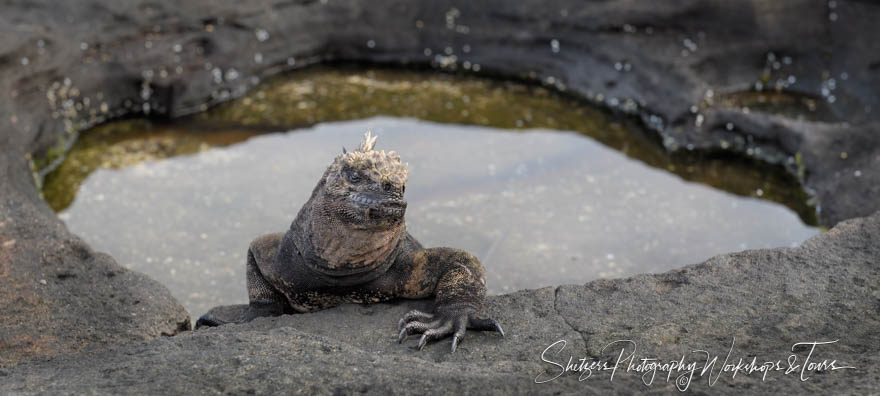
A Marine Iguana hangs out in one of the tidal pools in the coastal lava rock
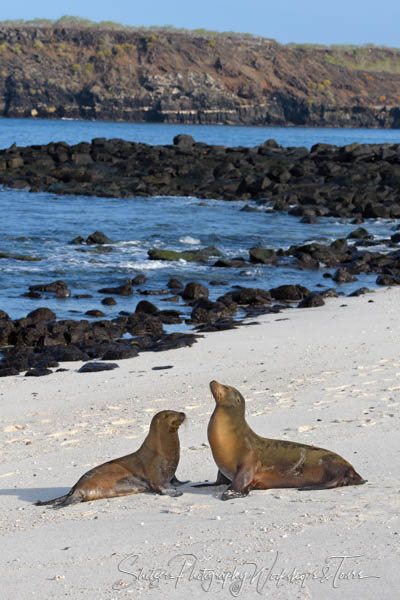
A pair of Galápagos sea lions enjoy each other’s company.
In the afternoon we head to the Charles Darwin Research Station in Puerto Ayora on Santa Cruz Island. We will learn about their work in the National Parks, and their programs for supporting subspecies of the giant tortoise. We also get to see giant tortoises being bred, in different stages of their life.
One of the highlights is learning about Lonesome George, a male Pinta Island tortoise. Lonesome George was estimated to be over one hundred years old, and was the last known individual of the species. His story is an important symbol of conservation, and shows the need for conserving biodiversity in the Galápagos Islands and the rest of the word.
The vegetation around the Charles Darwin Research Station is lush and green. Many Darwin’s finches are easy to locate as we walk around the facility.
Day 9 – North Seymour Island (15) and Baltra Island (1) and return to Quito, Ecuador
Early this morning we experience one of the best locations for blue-footed boobies, magnificent frigates, and greater frigates. As we depart the yacht, we will board the zodiac (a.k.a. the panga) and complete a dry landing on the island of North Seymour.
North Seymour is a flat uplifted island in the rain shadow of Santa Cruz Island, thus creating a dry vegetative and arid zone. As we tour the island, we will hopefully see the nesting, mating displays, and young of these unique birds.
The blue-footed booby males prance, displaying their colorful feet, as the female coos, looking for the right male to nest with. The male then lifts his wings and tail, and arches his neck, displaying he is “the one” to his future mate. The males compete for the female’s attention until she picks one. Many blue-footed booby babies and eggs are in these colonies as the bird’s nest here year-round.
The frigate males inflate their red balloon-like pouch to display for the females. It can take 20 minutes for the male to fully inflate and deflate the pouch. There is lots of commotion with all the male frigates trying to find a mate. The female frigates tend to prefer the males with the larger display, so the males will fully inflate to display as large as possible. There are frigate nests everywhere, and fuzzy babies on the nests, being fed by their parents.
As we spend our morning strolling around the island, we will look for nice photogenic compositions of the species below.
- Blue-footed booby (native)
- Great frigatebird (native)
- Magnificent frigatebird (native)
- Land Iguana (endemic)
- Elliot’s Storm Petrel (native)
- Galápagos Dove (endemic)
- Galápagos petrel (endemic)
- Sally Lightfoot Crabs
- Galápagos Sea Lion (endemic sub-species)
- Brown pelican (native)
- Lava Lizards (endemic)
- Marine Iguana (endemic)
In addition to the birds, the large and colorful land iguanas roam around eating the leaves and cactus. These amazing-looking creatures that resemble dragons can be found on the lava rock, amid the cactus, and on the sandy beaches.
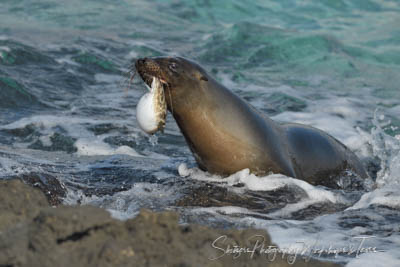
A Galápagos sea lion playing with puffer fish, flinging it all around the beach.
As we continue our walk, and visit a Galápagos sea lion area. As the sea lions return to the rocky beach for the evening, pups and mothers are reunited. Hopefully, we will see mothers nursing their pups and sea lion pups playing with each other.
Behaviors we hope to see while on North Seymour Island:
- Blue-footed boobies sitting on eggs
- Blue-footed boobies feeding their young
- Blue-footed boobies doing mating displays\dances
- Blue-footed boobies mating
- Blue-footed boobies rubbing beaks protecting their nesting site
- Magnificent Frigates inflating pouch for mating display
- Magnificent Frigates stealing others food and nesting materials
- Magnificent Frigates feeding their young
- Land Iguanas eating cactus and other plants
- Galápagos Sea Lions playing and nursing their young
- Marine Iguanas sunning themselves
- Galápagos gulls mating \ sitting on nests
We then return to Baltra Island in time for our morning flight back to Quito. We say goodbye to the crew and head back to the Baltra airport to conclude the workshop and begin our journey home or to our next adventure.
*For those guests doing both weeks, you will have a few hours of relaxation, and some time to catch up on your images.
ITINERARY CHANGES
The operator(s) and/or the captains of the yacht reserve the right to make changes to or cancel any part of the itinerary or programs without giving prior notice. Changes may be necessary due to unforeseen circumstances, such as new Galápagos National Park rules, public authority decisions, weather or natural disasters, force majeure, and/or any other extreme circumstances. These decisions will be made to avoid problems and protect the safety of the passengers. If we must make a change, we will offer the best possible alternatives or adjustments.
DIFFERENCES IN EAST VS WEST ITINERARIES
We offer two different itineraries for the Galápagos Islands. There is so much diversity in the islands that each location is very different. Each trip has subtle differences we have detailed below.
Still can’t decide? Join us for both itineraries on our Two-Week Galápagos workshop, and enjoy two weeks in the Galápagos Islands at a discounted rate.
- More boobies including Nazca and Red-footed
- Bobbies and Frigates, with nesting and mating displays
- Galápagos Fur Seals
- Galápagos Short-eared Owl
- Waved Albatross
- More birds
- More Greater Flamingos
- More Galápagos Green Turtles
- Flightless Cormorants
- More Galápagos History and Geography
- More Marine Iguanas, especially at Fernandina Island
- More wild Giant Tortoises
PRICE INCLUDES
- 9 Days / 8 Nights’ Galápagos Photography Workshop
- 8 Days / 7 Nights’ accommodation aboard Galápagos yacht – Double occupancy (Limited Single Occupancy available)
- 1 Night accommodation in Quito, Ecuador – Double occupancy (Single Occupancy available)
- Airfare from Quito, Ecuador to the Galápagos Islands and return
- Ground transportation to and from the Quito, Ecuador airport
- Ground transfers in the Galápagos Islands
- All shore excursions with an English-speaking Galápagos naturalist guide
- Snorkeling equipment: mask, tube and fins with size 34 – 45 included. (Optional)
- Ecuador Transit Control Card
- All meals are provided during the workshop. Expect to gain a couple of pounds on the trip.
- Instruction in the field with your photographer guides. (2 guides if 10 guests or more)
- Photography instruction on photo editing techniques
- A planning package that includes recommendations on the proper camera gear and clothing
- We take care of all the trip logistics once guests arrive Quito, so the only thing you should concentrate on is having a fantastic time and capturing stunning images in the Galápagos Islands
Anytime before you embark on your journey, our trip leader Matt is happy to provide a free phone consultation. He can give you guidance on what equipment to bring, answer questions about the locale, and give general photography advice to make sure you are ready to capture your dream images.
NOT INCLUDED
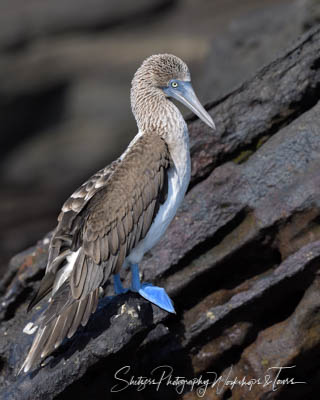
The iconic blue-footed booby
- Air Transportation to Quito, Ecuador from your home base and back
- Alcoholic drinks / Bottled beverages
- Personal Items
- Wet suits (Shorty wet suits in all sizes will be available to rent on board)
- Gratuities to yacht crew and local naturalist
- Galápagos National Park entrance fee
- Travel/Cancellation/Emergency evacuation insurance
PHYSICAL REQUIREMENTS
You should be in good physical health. You will be walking on trails with your camera gear for about 2 hours, typically 1-2 miles per destination. While most of the trails are smooth, some are on uneven terrain such as lava rock. You will need to be able to get in and out the zodiac boats, both on the yacht and in knee-deep water when we make wet landings. There are stairs/ladders on the boat which you will need to be able to go up and down comfortably.
If you are concerned about the physical demands of this trip, please contact us, and we will be glad to discuss options to accommodate your needs.
PHOTOGRAPHY SKILL LEVEL
Our Galápagos Photography Workshop is open to all photographers, from beginners to professionals.
WEATHER CONDITIONS
This is the perfect time to explore the Galápagos. The weather is ideal, neither too hot nor too cold. Low temperatures are typically around 72° Fahrenheit (22° Celsius), with highs of a pleasant 82° Fahrenheit (28° Celsius).
Expect very little rainfall — the islands average less than an inch for the month.
TRIP LEADERS
Matt Shetzer – Matt has been leading photographic workshops all over the world since 2011, and loves being outside and enjoying nature. To read more about Matt, click HERE.
INSTRUCTIONAL TOPICS
While our primary goal is maximum field time, we will take advantage of non-optimal photography conditions to provide photo workshops, discussing the following subjects in detail:
- Achieving the best composition
- Proper exposure for the scene
- Focus techniques for that crisp image
- Getting the most out of the histogram
- Mastering the modes (when to shoot manual, aperture and shutter priorities)
- Taking images for HDR (High Dynamic Range)
- Image workup techniques with Photoshop and Lightroom. At each workshop, we demonstrate how to work up attendees’ images from scratch, displaying our nondestructive techniques to produce the highest quality image.
- Best Plugins to use
- Color Correction
- Layers and Masks (Masks are targeted adjustments)
- Noise reduction and sharpening techniques
- Lightroom and portfolio management
- Photography discussions – Review select images and discuss which images work and why to expand your skills and move to the next level
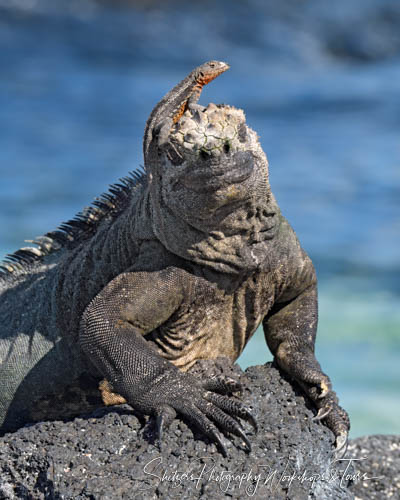
I am not sure why this Marine Iguana looks so happy with a Lava Lizard on its head.
CAMERA EQUIPMENT TO BRING
- A telephoto lens from 80 to 400mm
- A landscape lens from 24-70mm
- Camera Backpack
- Lots of memory cards. We typically shoot about 1,000 images a day. Bring more than you think you need.
Prior to the trip, you will receive a detailed planning package with recommendations for camera gear
NON-PHOTOGRAPHER GUESTS
The Galápagos Islands provide a spectacular experience for everyone. Whether you enjoy photography or just have a love for nature, there is something for you in the Galápagos Islands.
Non-photographers are welcome on the tour, and are free to join us on all activities at a discount of $250.00.
CLIENT COMMENTS
Read what our fantastic guests are saying out our workshops. Client Comments
GALLERIES
Images from some of our previous trips can be found in our GALLERIES

Volcano Santo Tomás on Isabela Island
CANCELLATIONS/TRIP INSURANCE
The Yacht requires all guests to have trip insurance that covers Covid from a third-party operator to protect your travel investment against medical emergencies, participant trip cancellations, trip interruption and delay, weather delays, missed connections, baggage loss or delay, emergency evacuation and repatriation or simply ‘Cancel for any reason coverage’.
Because Shetzers Photography must pay fees for reservations and leases of accommodations and transportation needs of the group far in advance of the workshop, all paid tour fees are non-refundable, non-transferable and cannot be applied to a future workshop. Shetzers Photography runs small group workshops and wants to ensure the workshops are not canceled due to participant cancellations thus impacting the participants who do not cancel. All tour cancellations must be submitted in writing and will result in loss of deposit and all fees paid.
Please review our Workshop Terms and Conditions.
COVID-19 and Variants Policy
If regulatory restrictions in the hosting location prevent the workshop from running as scheduled, the workshop will be rescheduled to a future date. All participants must meet hosting country vaccination requirements. No refunds or rescheduling will be allowed due to guest cancellations when the workshop is able to run following all host location regulatory restrictions.
WAITING LIST – IF A TRIP IS SOLD OUT
Over the last few years, all of our trips have sold out. We start to fill up about a year before the workshop, and keep the website updated with the current availability of space. If a workshop is full, you can add your name to the waitlist. If a spot becomes available, we will contact the guests on the waitlist immediately, in the order they signed up. We tend to have the most cancellations 90-180 days before a trip start, so being on the waitlist means you still have a good chance of getting on the trip. We require no deposit to get on the waitlist.
PAYMENT/RESERVATIONS
The cost for the tour is $7,995.00 USD based on double occupancy. We offer single accommodations for an additional $2,995.00 USD per person, which guarantees a single attendee a private cabin for the trip which is limited to availability of staterooms.
To reserve a spot on this tour, we require a $1,000.00 USD deposit per person, paid by credit card at the time of registration. $4,000 of the full amount of the workshop fee will be due approximately 13 months prior (March 1st) to the start of the workshop. The remaining payment for the workshop will be due approximately 4 months prior (February 1st) to the start of the workshop. Fees can be paid by check or bank transfer. All fees are non-refundable.
Galápagos Photography Workshop – West
TABLE OF CONTENTS
Trip HighlightsItinerary/Details Register Ask Question
Once we have received the final trip payment, we will send the detailed trip planning documents to each guest, to help them plan for their best possible photography workshop.
If you are not traveling with someone, we will assign you a roommate depending on group makeup and gender.
Our workshops are filled on a first come, first serve basis. Workshop availability will be updated on this page.
If you have any additional questions or would like to speak to one of us, please contact us at 303-888-2710 and we would be happy to answer your questions.

